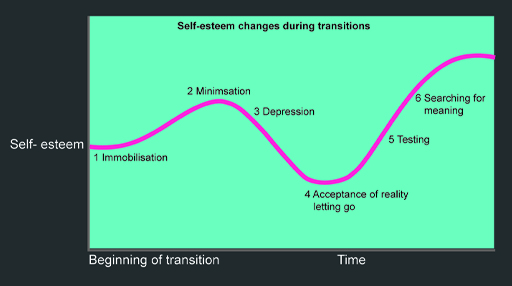3.6 Adjusting to change
Change can be beneficial and provide new opportunities but it can also be experienced as a source of stress. Some of the reasons for this include:
- Change can remove people from the comfort of what they know and who they know.
- Change can disrupt the equilibrium in people’s lives.
- Change can leave individuals feeling out of control.
- Change can bring new expectations and pressures from others.
- When people change they may worry about how other people see them.
- Sometimes, by changing, people are vulnerable to stigmatisation, prejudice and discrimination.
- Change can use up a lot of time, physical effort and emotional energy.
Transitions and change are an integral feature of life, particularly when a person moves to a new place or location, or experiences failing health or mobility. Typical transitions a social worker might be involved with include:
- helping a person relocate into a residential social care setting
- planning for adoption
- adjusting to life at home after long-term hospital care
- supporting a recently disabled person to adjust to life using a personal support assistant.
Social workers need to address not only the practical and logistical issues but also help the individual make psychological and emotional adjustments to their new circumstances. According to Hopson and Adams (1976), stressful transitions are those which are unpredictable, involuntary, unfamiliar or of high magnitude or intensity. However, transitions are always an opportunity for growth and change. Hopson and Adams (1976, p. 13) produced a model based on psychology that has been commonly used to help practitioners to understand how changes of place and location impact on an individual’s sense of wellbeing and self-esteem. They propose that individuals may experience similar patterns of feelings and emotions within the process of adjustment.
Hopson and Adams outline the following common stages of adjustment to self-esteem during periods of transition, and if successful, gradually rising over time:
The explanation of the various stages is:
Immobilisation: A sense of being overwhelmed, unable to act. Unfamiliar transitions, and those of which we have negative expectations, tend to intensify this stage.
Minimisation: As a way of coping with the change it is common to deny that it is happening. This is a frequent reaction to a crisis that is too difficult to face.
Depression: People often get depressed when they face up to the implications of change.
Accepting reality: At this point the person begins to let go of their old state of being, accepting the reality of what is happening to them.
Testing: Having begun to accept the situation, then it becomes possible to test out new behaviours to cope with the new situation.
Seeking meanings: This is a reflective stage where people try to work out how and why things are different.
Internalisation: Finally, understandings of the situation and new meanings become internalised and accepted. They then become part of the person’s behaviour.

When a social worker is seeking information about a person’s life history, the stages in Erikson’s theory could serve as useful prompts.

